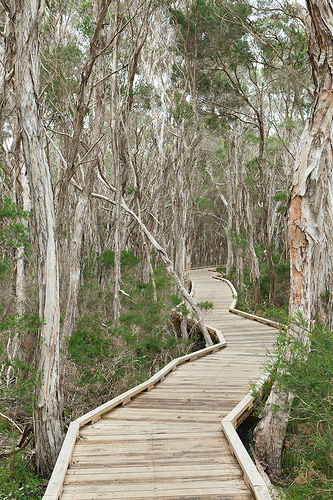I’m in a gallery looking at photographs. Well, in this context ‘photographs’ may be a misleading word. These images are on photographic paper but actually they’re abstract moments in chemistry and light. They comprise dribbles, daubs and geometric shapes in different tones of browns, oranges and blue. Apart from one image, which has the faint impression of a silhouetted head, there is nothing particularly ‘photographic’ or recognisable in what I see on these sheets of paper. I step into the next room. Here are journalistic portraits. These images feel far more accessible, and I realise that despite my openness to considering new applications of photography my true interest is in photojournalism. I notice the connection between this and my writing. ‘It’s non-fiction for me!’ I quip to my companion.
The heat in the gallery is stifling. So we head outside to deckchairs at Federation Square where I sit in the breeze by the river watching the world go by: non-fiction at its purest. Yet my eye is constantly drawn to the colour and movement on the big screen above the empty stage. At first I am ashamed at how easily the packaged visuals distract me from the non-fiction around me. But then I realise the advantage the screen has: story. That’s what makes the edited footage more interesting. It’s not pure non-fiction that I love. It's non-fiction stories.
I’ve always known that story is important to writing, but understanding and applying that as a writer can be difficult. When I am researching a non-fiction article I am generally able to find a good story (and angle). But when I’m writing something non-fiction that’s based on my own experience I get completely flummoxed. Of all the moments in any experience, which are relevant to the story? Recently I sat on a boardwalk next to an estuary, and I realised that I might be drawing closer to an answer for this question.
As I sat a fisherman appeared. He threw his line in the water and settled nearby. I asked him what he was fishing for. He answered. Then I asked him if there are fish that swim in the ocean as well as the estuary (forgive me, I don’t know about these things). ‘Well, I’ll tell you a story,’ the fisherman said. And then he proceeded to do quite the opposite. He started by noting a new housing development somewhere, and then there was some connection to his accountant, and something about his tax return. And then there was a barbeque (maybe in the accountant’s house?), and then we were back at the new housing development and it ends up it was built on a watercourse. And toward the end of all this noise I got the story: someone somewhere up a river once saw a gummy shark, and apparently that’s surprising.
Jack Hart’s book Storycraft: The Complete Guide to Writing Narrative Nonfiction, has been a turning point in my understanding of how best to tell stories. Thanks to him, I now have a mantra: ‘What does the reader need to know?’ By asking this constantly as I write personal (and other) non-fiction stories I feel more able to sort the story from less relevant real-life action: the gummy shark from the accountant, the big screen from the passing parade. If I don’t tell my readers what they need to know they will be sitting at a barbeque with an accountant when in fact I want them back at the gallery with the abstract photographs.
These abstract images contrast sharply with the photojournalism in the next room. Yet there is something curious in them for me and that comes from their story. The exhibition blurb explains that they are darkroom rejects – sheets of paper fished from rubbish bins then reinterpreted by photographers Greg Neville and Greg Wayn. The images alone are open to a wide interpretation. But once I have their story, I can picture much more.


